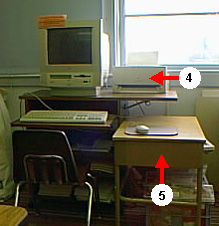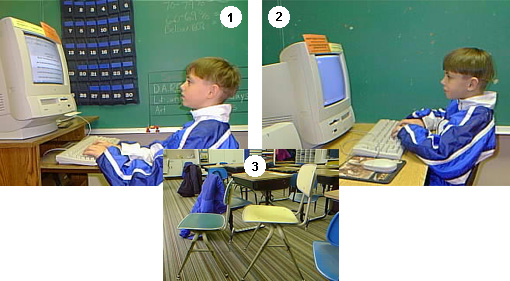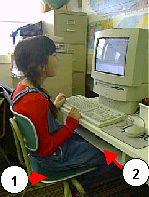Mouse location, monitor height, and seat height
These three case studies are intended to give you ideas for arranging a classroom where space and furniture for computers are sparse.
Mouse location
Case study: 2nd grade classroom
Concern
In this classroom, the mouse was located above and away from the keyboard. There was no space for it on the keyboard tray. The mouse could only be moved using a very long arm reach.
Before

The computer table had a keyboard tray (1) and side shelves (2). The printer was placed on a spare desk (3).
After

Extra space for the mouse was obtained by folding out the shelf for the printer (4) and moving the spare desk next to the keyboard tray (5).
Solution
To make a better arrangement for mouse use, the printer was placed on the folded-out side shelf on the computer table (4) and the spare desk was moved forward and placed level with the keyboard. The mouse was placed on the spare desk (5). The mouse, placed right next to the keyboard, could now be used with a comfortable posture.
Monitor height
Case study: 4th grade classroom
Concern
In this classroom, the computer monitor and the keyboard were too high. Students had to look up and bend their heads back to see the monitor. Their elbows were also lower than the keyboard.

Solution
This case could be solved two ways. In picture 1, the student could get eyes level with the computer monitor and elbows level with the keyboard with the help of a higher chair, shown in picture 3. The feet must be supported with a box or footrest.
Or, as in picture 2, the computer monitor was placed on a lower desk. The computer monitor is now at a good height. However, as you will note in picture 2, the student is pushing his shoulders up to type because the table is still too high for typing. A higher chair or an even lower desk is needed to resolve the problem.
Seat height
Case study
Concern
The student cannot type with her elbows level. The chair (1) is too low, but a higher one cannot be used due to the shelf under the desk (2). This shelf does not give the student enough leg room.

Solution
The shelf under the desk is easy to remove without damaging the table and a higher chair was available in the classroom.